|
ROYAL THEATRE OF TOONE
|

|
At the end of both the Impasse Schuddeveld and the Impasse 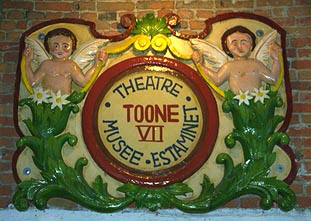 Sainte-Pétronille lies a
place that is very dear to the people of Brussels : the "Maison de
Toone" (the house of Toone). It is at the same time a typical
inn, with red Spanish
bricks, blackened beams and a tiled floor, and a puppet theatre in the attic,
with wooden benches, pillows with colorful scallops nailed into the rough,
wooden boards. Furthermore, there is a workshop where the puppets are made, a
library, a video library and a puppet museum where those who have retired
from the stage, the past heroes of Toone and other characters from puppet
players all over the world, are hung against the wall. Toone is a popular and
adoptive dynasty of puppet players. Actually, the name Toone is not
necessarily passed on from father to son : each new Toone has to be adopted by
his predecessor and by the public. Sainte-Pétronille lies a
place that is very dear to the people of Brussels : the "Maison de
Toone" (the house of Toone). It is at the same time a typical
inn, with red Spanish
bricks, blackened beams and a tiled floor, and a puppet theatre in the attic,
with wooden benches, pillows with colorful scallops nailed into the rough,
wooden boards. Furthermore, there is a workshop where the puppets are made, a
library, a video library and a puppet museum where those who have retired
from the stage, the past heroes of Toone and other characters from puppet
players all over the world, are hung against the wall. Toone is a popular and
adoptive dynasty of puppet players. Actually, the name Toone is not
necessarily passed on from father to son : each new Toone has to be adopted by
his predecessor and by the public.
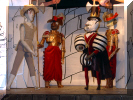 The oldest Toone dates back from 1830. He was born in 1804 and was called Antoine
Genty. He had an exceptionally long "reign" of forty-five years. Between
1830 and 1890 Toone, which is short for "Antoine" in the
Brussels dialect, played "Ourson et Valentin", "Vivier et
Malgase", "Les Quatre Fils Aymon" and a number of religious
plays. He was seen in the area of the Rue des Sabots (presently Rue de Wynants), Rue du Miroir, Rue des Vers (Rue
Pieremans), Rue Christine and the Impasse des Liserons, before ending his days in a home. The oldest Toone dates back from 1830. He was born in 1804 and was called Antoine
Genty. He had an exceptionally long "reign" of forty-five years. Between
1830 and 1890 Toone, which is short for "Antoine" in the
Brussels dialect, played "Ourson et Valentin", "Vivier et
Malgase", "Les Quatre Fils Aymon" and a number of religious
plays. He was seen in the area of the Rue des Sabots (presently Rue de Wynants), Rue du Miroir, Rue des Vers (Rue
Pieremans), Rue Christine and the Impasse des Liserons, before ending his days in a home.
Toone II (1848-1895), also known as Jan van de Marmit because his theatre was called
"In de Marmit", was actually named François Taelemans. He played
from 1865 until he died. He lived in the same building as Toone the Elder,
who became his son's godfather. He too never left the quarter of
the Marolles. And he was the one who is going to be called Toone II in the
genealogy that was established by the "Les Amis de la Marionnette"
(the friends of the puppet) in 1931.
Georges
Hembauf (1866-1898), Toone III, was trained by François Taelemans. His
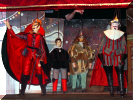 nickname was "Toone de Locrel" as he had established his puppet cellar
in the Impasse de Locrel that borders on the Rue de la
Rasière. In the newspaper "La Réforme", he declares in 1897 that
his theatre was the only one of the about fifteen theatres in the Brussels
region that did not loose its public and saw its reputation increase. He
employed ten workers and a chief scene-shifter, and a collection of four
hundred puppets. His repertoire encompassed no less than 1000 pieces, under
which "La Belle Gabrielle", "La Guerre de Charlemagne",
(the war of Charlemagne) "Le Bossu" (the hunchback), "Hamlet" and "La
Bataille de Waterloo" (the battle of Waterloo). nickname was "Toone de Locrel" as he had established his puppet cellar
in the Impasse de Locrel that borders on the Rue de la
Rasière. In the newspaper "La Réforme", he declares in 1897 that
his theatre was the only one of the about fifteen theatres in the Brussels
region that did not loose its public and saw its reputation increase. He
employed ten workers and a chief scene-shifter, and a collection of four
hundred puppets. His repertoire encompassed no less than 1000 pieces, under
which "La Belle Gabrielle", "La Guerre de Charlemagne",
(the war of Charlemagne) "Le Bossu" (the hunchback), "Hamlet" and "La
Bataille de Waterloo" (the battle of Waterloo).
The history of the Toones gets complicated as
there was another legitimate pretender to
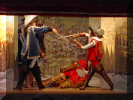 the title of Toone III : Jan
Schoonenburg (1852-1926), hatter by trade. Because his hat covered
his abundant hair, he was called "Jan de Crol" (Curly
John). According to Louis Quiévreux, a
journalist, he was undoubtedly a great artist. When he played "Les Trois Mousquetaires"
(The Three Musketeers), "Vingt Ans Après" or "Le Vicomte de
Bragelonne", he performed them for two months, and every night one would
notice the same regular visitors sitting on the benches. But the competition
between the dance-halls and the cabarets became increasingly tough, and Toone
de Crol ended up losing his public. One evening in 1926 he was found hung
among his puppets. the title of Toone III : Jan
Schoonenburg (1852-1926), hatter by trade. Because his hat covered
his abundant hair, he was called "Jan de Crol" (Curly
John). According to Louis Quiévreux, a
journalist, he was undoubtedly a great artist. When he played "Les Trois Mousquetaires"
(The Three Musketeers), "Vingt Ans Après" or "Le Vicomte de
Bragelonne", he performed them for two months, and every night one would
notice the same regular visitors sitting on the benches. But the competition
between the dance-halls and the cabarets became increasingly tough, and Toone
de Crol ended up losing his public. One evening in 1926 he was found hung
among his puppets.
Jean-Baptiste Hembauf (1884-1966) the son of
Toone de Locrel, directed his theatre as Toone IV for thirty years. For
the first time, the name Toone was passed on from father to son. Since his
father had sold all his puppets, he started working together with a puppet
manufacturer, Antoine Taelemans, the son of Toone II. It was Toone IV who
created the play "Le Mystère de la Passion de Notre Seigneur
Jésus-Christ" on the 30th of March 1934, a puppet play which had been
written down by Michel de Ghelderode according to oral tradition. He also
warmly approved the choice of Jef Bourgeois, a painter from the
Marolles, as the guardian of the puppet play, and invested José Géal with the
sword of the puppet Charlemagne before he crowned him Toone VII.
Daniel Vanlandewijck (1888-1938) came into
office as Toone V in a cellar of the Impasse
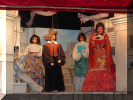 Sainte-Thérèse. Everything went
well until the day when the Commission for Hygiene of the City of Brussels
decided to close the hall for reasons of insalubrity. In a fit of depression,
Toone V sold all his puppets. However, a small group called "Les Amis de
la Marionnette" (the friends of the puppet) was willing to save this
essential element of the Brussels folklore. Its members were, amongst others,
Adolphe Max, Burgomaster of Brussels, Marcel Wolfers, a sculptor-jeweler (who had
bought the collection of puppets that was in danger of being dispersed and offered it to the new
theatre) and Jef Bourgeois, who became the first
curator of the theatre. The new hall in Rue Christine was inaugurated in the
presence of Adolphe Max on the 31st of March 1931. Sainte-Thérèse. Everything went
well until the day when the Commission for Hygiene of the City of Brussels
decided to close the hall for reasons of insalubrity. In a fit of depression,
Toone V sold all his puppets. However, a small group called "Les Amis de
la Marionnette" (the friends of the puppet) was willing to save this
essential element of the Brussels folklore. Its members were, amongst others,
Adolphe Max, Burgomaster of Brussels, Marcel Wolfers, a sculptor-jeweler (who had
bought the collection of puppets that was in danger of being dispersed and offered it to the new
theatre) and Jef Bourgeois, who became the first
curator of the theatre. The new hall in Rue Christine was inaugurated in the
presence of Adolphe Max on the 31st of March 1931.
Because this hall was too small, the theatre
of Toone V soon moved to the Impasse de Varsovie, where the first
"pornographic" performance took place. During this play, a stark
naked Woltje has a lot of fun with a "toffe mokske" (nice girl) in his
bed. The puritan part of the audience shouted
"Curtain !", and urged by the right-minded press, the theatre had to
close for several days. Daniel Vanlandewijck passed away in the Hospital Saint-Pierre in May 1938.
Pierre Welleman (1892-1974), also known as
"Peïe Pââp" (Peter with the pipe), takes over in
the Impasse de Varsovie as Toone VI. However, during a November night
in 1944, the only V-bomb that fell on Brussels hit the ground only a few
steps away from Toone's cellar. Seventy-five puppets were destroyed in the
disaster. Because the door of the cellar was smashed to bits and its roof
collapsed, Pierre Welleman gathered the debris of his troupe, took it to the
Rue Notre-Dame-de-Grâce, and stored the puppets in an old stable that had
been transformed into a cart depot.
On the occasion of the creation of the
"Farce de la Mort qui faillit trépasser" (farce of the
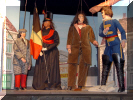 death who
almost passed away) by Toone VI, Michel de Ghelderode wrote an homage to all Toone's : "Toone, Rex
Marollorum". In October 1956, Toone VI was forced to move and he
installed his small universe in café "Le Lievekenshoek" (lover's
corner) on the Place de la Chapelle. But television, second residences and
caravans, football and the growth of the car park kept the public away from
the "poechenellekelder" (puppet cellar). The death-blow came in March
1963, when Toone VI was expropriated once more. His old age and ill health
prevented him from fighting back. death who
almost passed away) by Toone VI, Michel de Ghelderode wrote an homage to all Toone's : "Toone, Rex
Marollorum". In October 1956, Toone VI was forced to move and he
installed his small universe in café "Le Lievekenshoek" (lover's
corner) on the Place de la Chapelle. But television, second residences and
caravans, football and the growth of the car park kept the public away from
the "poechenellekelder" (puppet cellar). The death-blow came in March
1963, when Toone VI was expropriated once more. His old age and ill health
prevented him from fighting back.
Once again, it was Jef Bourgeois, the curator
of the museum, who saved the puppets by creating "Les Amis de
Toone" (the friends of Toone). This group was temporally housed in
the cellars of the Maison du
Roi
on the
Grand Place. Jef Bourgeois, together
with Jean-Baptiste Hembauf, insisted that José Géal, who had had a great
success with his interpretation of "La Tentation de
Saint-Antoine" (the temptation of Saint-Anthony) on his farewell party,
assured the continuation of the Toone dynasty.
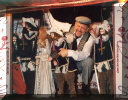 José Géal, a man of popular Brussels
descent, had the advantage of being a professional puppet
player . After having been an actor for the
National Theatre of Belgium for two years, he created the "Theatre des Enfants" (children's theatre) in
1954. It was the first professional puppet theatre for children. After the
World Exposition of 1958, where he received a gold medal, he started to make
programs
for the Belgian Radio and Television. He is the father of "Plum-Plum"
and "Bonhommet et Tilapin". In 1962, he was elected president of
the Union Internationale de la Marionnette (International Union of the Marionette)
during a meeting in
Warsaw. José Géal, a man of popular Brussels
descent, had the advantage of being a professional puppet
player . After having been an actor for the
National Theatre of Belgium for two years, he created the "Theatre des Enfants" (children's theatre) in
1954. It was the first professional puppet theatre for children. After the
World Exposition of 1958, where he received a gold medal, he started to make
programs
for the Belgian Radio and Television. He is the father of "Plum-Plum"
and "Bonhommet et Tilapin". In 1962, he was elected president of
the Union Internationale de la Marionnette (International Union of the Marionette)
during a meeting in
Warsaw.
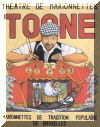 José Géal was enthroned as Toone VII
at the Place de Brouckère on the 10th of December 1963. With the support of
Toone IV (Hembauf) and Toone VI, he gave the Toone Theatre the statutes of a
non-profit association. He also managed to acquire a dilapidated 17th century
house in the Ilot Sacré, in the middle of the Petite
Rue des Bouchers. After a rough renovation, the Toone Theatre was
inaugurated with "La Passion" by Michel de Ghelderode on the 1st of
April 1966. It was not until 1979 that the final restoration of the theatre
could be carried out. José Géal was enthroned as Toone VII
at the Place de Brouckère on the 10th of December 1963. With the support of
Toone IV (Hembauf) and Toone VI, he gave the Toone Theatre the statutes of a
non-profit association. He also managed to acquire a dilapidated 17th century
house in the Ilot Sacré, in the middle of the Petite
Rue des Bouchers. After a rough renovation, the Toone Theatre was
inaugurated with "La Passion" by Michel de Ghelderode on the 1st of
April 1966. It was not until 1979 that the final restoration of the theatre
could be carried out.
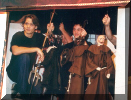 On
September 16, 2000, for the 40th anniversary of the Free Commune of Ilot
Sacré, José Géal yields for the first time its place to his son Nicolas Géal who
interprets all the voices of "Duvelor ou la Farce du Diable
vieux" (Duvelor or the Joke of the old
Devil) from Michel de Ghelderode. In front of a conquered room, the Burgomaster of
Brussels, François-Xavier de Donnea, exclaims: "the taking over is ensured!". On
September 16, 2000, for the 40th anniversary of the Free Commune of Ilot
Sacré, José Géal yields for the first time its place to his son Nicolas Géal who
interprets all the voices of "Duvelor ou la Farce du Diable
vieux" (Duvelor or the Joke of the old
Devil) from Michel de Ghelderode. In front of a conquered room, the Burgomaster of
Brussels, François-Xavier de Donnea, exclaims: "the taking over is ensured!".
 Forty years day for day after the enthronement of his father
by Jean-Baptiste Hembauf, on December 10, 2003, it is the turn of Nicolas Géal
to be established in the Town hall under the name of Toone VIII, under the aegis of Freddy Thielemans,
Burgomaster of the town of Brussels. At this occasion, Nicolas Géal interprets "Genevieve of Brabant",
opera for puppets from Erik Satie, accompanied on the piano by the virtuoso Pierre-Alain
Volondat, prize winner of the Queen Elizabeth International Contest in 1983. Forty years day for day after the enthronement of his father
by Jean-Baptiste Hembauf, on December 10, 2003, it is the turn of Nicolas Géal
to be established in the Town hall under the name of Toone VIII, under the aegis of Freddy Thielemans,
Burgomaster of the town of Brussels. At this occasion, Nicolas Géal interprets "Genevieve of Brabant",
opera for puppets from Erik Satie, accompanied on the piano by the virtuoso Pierre-Alain
Volondat, prize winner of the Queen Elizabeth International Contest in 1983.
|

 Sainte-Pétronille lies a
place that is very dear to the people of Brussels : the "Maison de
Toone" (the house of Toone). It is at the same time a
Sainte-Pétronille lies a
place that is very dear to the people of Brussels : the "Maison de
Toone" (the house of Toone). It is at the same time a 




 José Géal
José Géal


